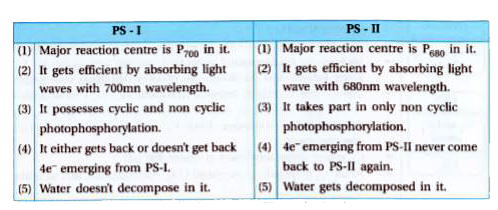PS - I and PS - II
Topper's Solved these Questions
- PHOTOSYNTHESIS IN HIGHER PLANTSBOOK - KUMAR PRAKASHANCHAPTER - PHOTOSYNTHESIS IN HIGHER PLANTSEXERCISE - SECTION - C (DEFINITION / EXPLANATION - TERMS / LOCATION - FUNCTION / FULL NAME) (DEFINITIONS / EXPLANATION :(1 MARK)
27 Videos
- PHOTOSYNTHESIS IN HIGHER PLANTSBOOK - KUMAR PRAKASHANCHAPTER - PHOTOSYNTHESIS IN HIGHER PLANTSEXERCISE - SECTION - D (TEXTUAL EXERCISE)
10 Videos
- PHOTOSYNTHESIS IN HIGHER PLANTSBOOK - KUMAR PRAKASHANCHAPTER - PHOTOSYNTHESIS IN HIGHER PLANTSEXERCISE - FILL IN BLANKS
10 Videos
- NEURAL CONTROL AND COORDINATIONBOOK - KUMAR PRAKASHANCHAPTER - NEURAL CONTROL AND COORDINATIONEXERCISE - OBJECTIVE SECTION (FILL IN THE BLANKS)
12 Videos
- PLANT GROWTH AND DEVELOPMENTBOOK - KUMAR PRAKASHANCHAPTER - PLANT GROWTH AND DEVELOPMENTEXERCISE - OBJECTIVE SECTION (FILL IN THE BLANKS)
7 Videos
Similar Questions
which of the given statements are true regarding PSI and PSII? a. both are found on stroma lamellae b. both are involved in non cyclic flow of electrons c. only PSII is associated with the release of O2 d. PSII lies on outer surface where as PSI lies on inner surface of thylakoids
View SolutionAssertion: The stoma lamellae have both PS I and PS II.
Reason: The grana lamellae lack PS II and well as NADP reductase enzyme. Photosynthesis in Higher Plants
A If both assertion and reason are true and reason is the correct explanation of assertion
B If both assertion and reason are true but reason is not the correct explanation of assertion
C If assertion is true but reason is false
D If both assertion and reason are false
View Solution
Knowledge Check
Assertion: PS I and PS II are named in sequence of their function during the light reaction or photochemical phase.
Reason: Each photosystem has one molecule of chlorophyll-a forming a light harvesting complex called antenna.AIf both assertion and reason are true and the reason is the correct explanation of the assertion.BIf both assertion and reason are true but reason is not the correct explanation of the assertion.CIf assertion is true but reason is false.DIf both assertion and reason are false.Read the following statements and mark the correct option- (i)Grana lamellae have both PS-I and PS-II, (ii) ph inside the thylakoid lumen decreases when H+ gradient is established across thlakoid membrane, (iii) During reduction of NADP to NADPH + H+ protons are removed from thylakoid lumen, (iv) Melvin Calvin used radioctive 14^C in a dicot plant to elucidate path of carbon in biosynthetic phase of photosynthesis.
A(i) and (iii) are correctB(i) and (ii) are correctC(i) and (iv) are correctD(i) and (ii) are incorrectThe PS Il and PS I in Z-scheme are connected by
AElectron transport systemBLight harvesting complexCCyclic photophosphorylationDNon-cylic photophosphorylation
Read the following statements and mark the correct option-
(i)Grana lamellae have both PS-I and PS-II.
(ii) ph inside the thylakoid lumen decreases when H+ gradient is established across thlakoid membrane
(iii) During reduction of NADP to NADPH + H+ protons are removed from thylakoid lumen
(iv) Melvin Calvin used radioctive 14^C in a dicot plant to elucidate path of carbon in biosynthetic phase of photosynthesis.
View SolutionSplitting of water molecules during light reaction of photosynthesis is associated with (a) PS I resulting the release of O2, protons and transfer of electrons to PS II (b) PS II resulting in release of O2, protons and transfer of electrons to PS I (c) PS II resulting in release of O2, protons and transfer of electrons to PS II (d) PS I resulting in the release of O2, protons and transfer of electrons to PS I.
Of the above statements
View SolutionThe electron flow from PS-II to NADP via ETS and PS - I follows
View SolutionSplitting of water molecules during light reaction of photosynthesis is associated with (a) PS I resulting the release of O2, protons and transfer of electrons to PS II (b) PS II resulting in release of O2, protons and transfer of electrons to PS I (c) PS II resulting in release of O2, protons and transfer of electrons to PS II (d) PS I resulting in the release of O2, protons and transfer of electrons to PS I.
Of the above statements
View SolutionCyanobacteria differes from bacteria in many respects in :
1. Complete absence of flagella
2. Presence of both PSI, PSII
3. Photosynthesis is anoxygenic
4. Carotenes and Chlorophylls are present
View Solution

